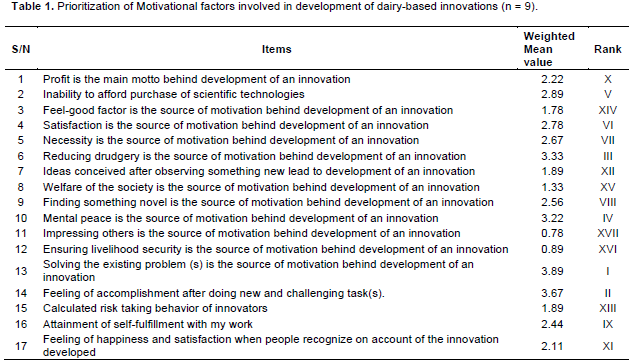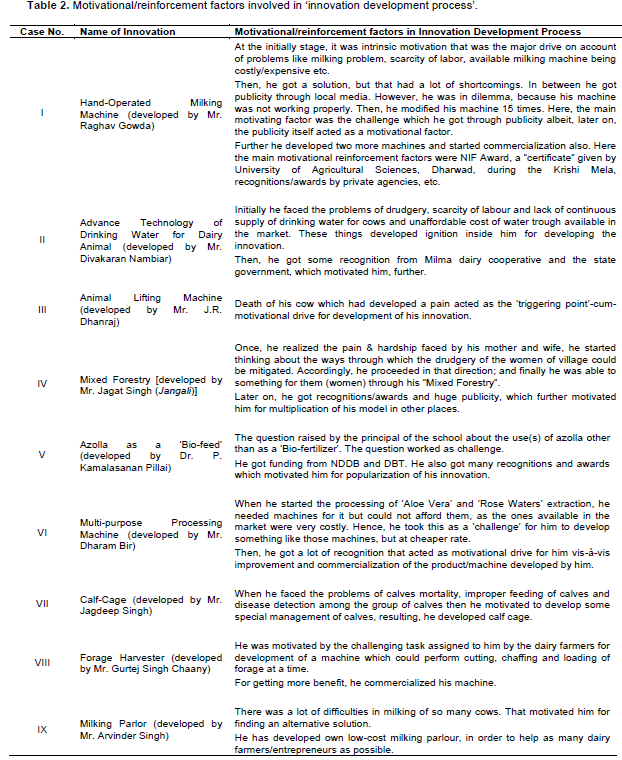Agricultural innovations are crucial for attainment of food security and poverty reduction; this fact is universally accepted. Farmers are not only recipients of introduced scientific technologies. It is a well known fact that agricultural innovations can emerge from multiple sources including farmers; in fact, farmers have been innovating long before the emergence of formal research and development. These innovations are commonly known as farmers’ innovation or local innovation or grassroots innovation. There are various determinants responsible for farmers led innovation development process. Motivation happened to be an important parameter to make farmers innovators.
Motivation is derived from Latin word ‘movere’ which means to move. Motivation may be defined as “the attribute that moves us to do or not do something”. Motivation refers to the initiation, direction, intensity and persistence of human behavior (Atkinson, 1966). Internal and
external factors that stimulate desire and
energy in people to be continually interested and committed to a
job,
role or subject, or to make an effort to attain a
goal is known as motivation (Business Dictionary). Motivation is of two types; intrinsic motivation, which refers to doing something because it is inherently interesting or enjoyable and extrinsic motivation, which refers to doing something because it leads to a separable outcome (Ryan and Deci, 2000).
Amabile (1983) stated that intrinsic motivation is encouraging to creativity, but extrinsic motivation is detrimental. Winston and Baker (1985) have done a review of more than 20 behaviorist studies, and finally concluded that there was compelling evidence that reward can be used to enhance divergent thought. Mumford (2003) assumed creativity to be strongly affected by interest in tasks for their own sake (“intrinsic motivation” or “intrinsic task interest”).
‘Innovations only develop in the laboratories’, is a myth which prevails among a large section of our society. However the fact is that people also develop some innovations outside the limits of the laboratories (Biggs and Clay, 1981; Biggs, 1990; Reij and Waters-Bayer, 2001). Whenever farmers face a typical problem, they try to find solutions. And sometimes these solutions turn out to be innovations in making. Without motive, we never do anything; motive may be varying from individual to individual or situation to situation, even these may vary from time-to-time within the same individual. Motives have been linked with the human action and have been the subject of investigation by researchers (McClelland, 1961). There are a number of factors responsible for motivating farmers to develop grassroots innovations. Increasing climate variability affects livestock production systems in all parts of the world, and will inevitably impact the resource poor families whose livelihoods are wholly or partially dependent on livestock (Thornton, 2013) which may induce farmers to innovate in order to adopt. The scarcity of resources and availability of costly inputs in the market vis-à-vis dairying could also lead to the development of input-saving innovations. A grassroots innovator may innovate out of curiosity, serendipity, peer pressure or interest in increasing production or solving problems (Millar, 1994; Nielsen, 2001; Leitgeb, 2014). Therefore, this study was conducted to find out the motivational factors affecting the selected dairy-based innovators vis-à-vis innovation-development.
In view of the nature as well as significance of the study, the “Case Study” method was adopted as the method of exploration. The cases were selected, purposively, on the basis of data-base compiled and documented by National Innovation Foundation (NIF), Ahmedabad. Other sources besides NIF were also used, viz. NGOs, Progressive Dairy Farmers Associations (PDFA) of states like Haryana and Punjab, personal interactions with Scientists and KVK staff working at the grass roots, etc. Nine such innovations were selected for this study, which were having relevance in the field of dairying. Data was collected with the help of motivational scale, which was developed for this particular study and the cases were analyzed for identifying the motivational factors involved in development of dairy based innovations.
Without motivational drive, we never initiate anything. A number of factors are involved in the development of an innovation. Motivation is one of the prime factors behind development of an innovation. But motivational factors vary from innovator to innovator because of personal and contextual factors. For starting any creative work, an individual needs strong intrinsic motivation and self-determination drive; because, in creative thinking, there is always high probability of failure. In this study, motivational factors involved in innovation development have been identified and prioritized; and these have been given subsequently.
Under this study, seventeen motivational factors were identified. From the Table 1, it is quite evident that “problem” happened to be the prime motivation factor in development of innovation, followed by “challenging task” and “reducing the drudgery” respectively. Subsequently, “mental peace”, “inability to afford available technologies” and “satisfaction” were found to occupy fourth, fifth and sixth rank, respectively. The moderately contributing motivational factors were “necessity”, “hope of getting something novel”, “attainment of self-fulfillment”, “profit”, “recognition”, “ideas conceived after observing something new” which were occupying seventh, eighth, ninth, tenth, eleventh and twelfth rank, respectively. The least contributing motivational factors were “calculated risk taking behavior”, “praise”, “feel-good factor”, “ensuring livelihood security” and “impressing others” which occupied thirteenth, fourteenth, fifteenth, sixteenth and seventeenth rank, respectively.
Motivational/reinforcement factors in innovation development process
Under this study, the nine cases of innovation develop-ment processes were analyzed with the help of longitudinal analysis of the respective processes. It was found that there were some motivational factors that played crucial role in the particular stages of innovation development process, which have been summarized as follows.
In Table 2 also it was quite evident that in all nine cases, the triggering-point of innovation development by the grass-root level innovators happened to be problems and/or challenging task. That indicated that the ‘problem’ and ‘challenging task’ were the prime motivating factors for innovation development at the grass-root level. In fact, all aforementioned factors are the cause of intrinsic motivation. From this study, it becomes clear that intrinsic motivation is directly responsible at the start of the innovation development process. Amabile (1983) claimed that people create something because of the intrinsic satisfaction they get from the very process of creation. These findings are in line with the findings of other related studies (Millar, 1993; Nielsen, 2001; Kummer, 2011). Eisenberger and Shanock (2003) delineated the importance of self-determination and intrinsic motivation for creativity. Mumford (2003) also stated creativity to be strongly affected by interest in tasks for their own sake (“intrinsic motivation” or “intrinsic task interest”). These three studies further strengthen the findings of this study. In Table 1 it was also found that “inability to afford available technologies”, “satisfaction”, “necessity”, “hope of getting something novel”, “attainment of self-fulfillment”, “profit”, “recognition”, “ideas conceived after observing something new” which were occupying the ranks of fifth, sixth, seventh, eighth, ninth, tenth, eleventh and twelfth respectively. In Table 2 also, it was found that recognitions, award and profit were the important motivational factors responsible for further development and commercialization of technologies. Eisenberger and Shanock (2003) mentioned that careers of outstanding scientists and mathematicians suggest that anticipated rewards often increase creativity. Eisenberger et al. (1999) carried out research with college students indicating that a reward contingency requiring a high level of performance increased perceived self-determination and perceived competence, both of which enhanced intrinsic task interest. Moreover, in field studies, employees’ expectation of financial rewards for high job performance was associated with perceived self-determination that, in turn, was related to heightened intrinsic interest in daily job activities. The positive relationship between reward expectancy and intrinsic task interest was greater among employees with a strong desire for control, indicating the importance of rewards as an indicator of self-determination. Winston and Baker (1985) have done a review of more than 20 behaviorist studies and concluded that there was compelling evidence that reward can be used to enhance divergent thought. These studies further enhanced the findings of this study.


The results of this study reveal that motivational factors varied from individual to individual. But, a few things were common: Intrinsic motivational factors are key in the beginning of innovation development process, followed by recognition, reward, and profit (extrinsic motivational factors), which play key role in further reinforcement of innovation development as well as development and commercialization of innovation.
The authors have not declared any conflict of interests.

